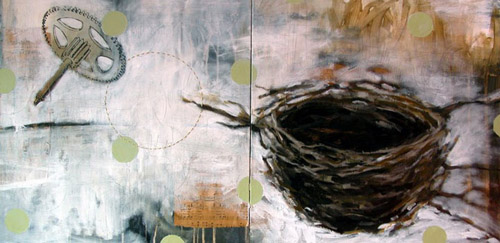If you think you don’t have much to say about your art, you’re not trying hard enough. Good content is everywhere, but it has to incubate. If you have a presentation coming up, start developing your content immediately. Give yourself time to play around with it, to make mistakes, and to tighten up your slides and words.
Find last week’s tips for designing your presentation PowerPoint or Keynote slides.
 |
| Lisa Kairos, Gear Nest. Acrylic and mixed media, 12 x 24 inches. ©The Artist |
Here are some tips for unearthing and refining your presentation content.
THOSE ANNOYING QUESTIONS
What questions are people asking you about your art? Every time someone asks you a new question, write it down–even if you don’t yet have the response to it. If they’re thinking it, someone else is bound to be thinking the same thing. You can turn what you might have otherwise considered annoying into a positive: free ideas!
PLAY OFFENSE
There’s a whole section in I’d Rather Be in the Studio! about playing offense–about taking charge of how your art is perceived rather than waiting for responses. You can do this in your presentations. Settle on the two or three most important things you want the audience to remember about you and your art. Build your talk around these points–citing them at the beginning and recapping them again at the end of your presentation. Use the time in-between to lay out your evidence and argument.
MINE YOUR BLOG
Blogging is a wonderful playground for gathering your thoughts. Just think of all those words you’ve written about your art! Go back to your best posts and the posts that received the most comments. Mine them for your presentation. Do the same with your journal writings and newsletters. (More free ideas!)
MIND MAP
A mind map is a way to generate ideas around a central theme. For instance, if you have a work that you know you want to talk about but don’t know what to say, start with a blank piece of paper. Put the title or an image of the work in the center of the paper. From the center, create branches for everything you can think of related to that artwork (medium, subject, mood, size, etc.).
Mind mapping is like brainstorming. It fleshes out a vague idea and shows you the many directions in which you could expand that idea. I begin almost every newsletter and blog post with a mind map.
There’s more on presentations and gallery talks in I’d Rather Be in the Studio! (pages 53-67)
KNOW THIS———-~> Content is all around you, but you have to pay attention to it.
THINK ABOUT THIS—~> Are you allowing enough time for your presentation content to incubate?
DO THIS————~>Pack your presentation with meaningful content. Start gathering your ideas the moment you have a date for your gallery talk, lecture, or slide show. Open up your mind to the questions that are being asked of you, the things other artists are saying about their work, and the possibilities that are inherent in the art itself. Keep your ideas in a single place–either in a notebook, a file, or on your computer. Gather, organize, refine, gather, organize, refine.
Give us your tips and listen to the podcast on the Art Biz Blog.


